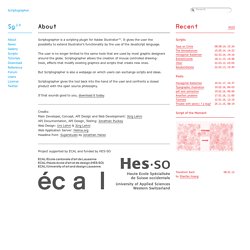Zoom
Trash
Related: Gender
- Microwave and RF
- EduOnline
- Tech
- A lire
- programming
- tech
- WEB DEV
- Paul Ford: What Is Code?
- Education
- Enterprise

LoveBits. What’S New Media For Lev Manovich. - About. Scriptographer is a scripting plugin for Adobe Illustrator™.

It gives the user the possibility to extend Illustrator’s functionality by the use of the JavaScript language. The user is no longer limited to the same tools that are used by most graphic designers around the globe. Scriptographer allows the creation of mouse controlled drawing-tools, effects that modify existing graphics and scripts that create new ones. But Scriptographer is also a webpage on which users can exchange scripts and ideas. Scriptographer gives the tool back into the hand of the user and confronts a closed product with the open source philosophy.
Paul Ford: What Is Code? A computer is a clock with benefits.

They all work the same, doing second-grade math, one step at a time: Tick, take a number and put it in box one. Tick, take another number, put it in box two. Tick, operate (an operation might be addition or subtraction) on those two numbers and put the resulting number in box one. Tick, check if the result is zero, and if it is, go to some other box and follow a new set of instructions. You, using a pen and paper, can do anything a computer can; you just can’t do those things billions of times per second. Apple has always made computers; Microsoft used to make only software (and occasional accessory hardware, such as mice and keyboards), but now it’s in the hardware business, with Xbox game consoles, Surface tablets, and Lumia phones.
So many things are computers, or will be. Hummingbird Robotics Kit - BirdBrain Technologies. Jitterbug - BirdBrain Technologies. Tiny Drummer - BirdBrain Technologies. Build - BirdBrain Technologies. Animatronic Mouths. Any robot that you build will likely need the ability to speak since it is the primary method of communication for us humans.

To create a sense of realism in your animatronics a mouth that actually moves presents a more believable animatron, even if it does not mimic a human's mouth perfectly. Alternate approaches to using moving mouths involve spectrography or just lighting up LEDs. In this tutorial I will show you two simple methods for building a believable robotic mouth. One articulated and moveable, the other an LCD flashing design. Both animatronic mouth designs create a believable illusion for your animatronic robot and can be built on a modest DIY budget. Animatronic Mouths Demonstration Video Articulated Animatronic Mouth LCD Robotic Mouth Purpose & Overview of this project This tutorial aims to create two different styles of robotic mouths.
Build yourself a cool cognitive cardboard robot - Cognitive Voices - Medium. How To Teach Artificial Intelligence. 5,010 views|Feb 12, 2020,5:00 am Tom Vander ArkContributorOpinions expressed by Forbes Contributors are their own.

I write about the future of learning, work and human development. Artificial intelligence—code that learns—is likely to be humankind’s most important invention. It’s a 60-year-old idea that took off five years ago when fast chips enabled massive computing and sensors, cameras, and robots fed data-hungry algorithms. We’re a couple of years into a new age where machine learning (a functional subset of AI), big data and enabling technologies are transforming every sector. A World Economic Forum report indicated that 89% of U.S. Given these important and rapid shifts, it’s a good time to consider what young people need to know about AI and information technology. Recognizing AI. Computers perceive the world using sensors. Grade span expectations will be available from the organization this summer. AI-focused learning objectives for K-12 schools. Using AI. Building AI. Start a Club - Girls Who Code.
DIY Cardboard Paper Robot by mrSunshiner. Coetry. Recently, I have been really interested in the question what programming really is, and how we can practice getting better at it.

I explored many weird things, like the relationship between code and painting. I gave a workshop in Cambridge where people got artwork styles, like Rococo, Graffiti and Expressionism, and they had to create an algorithm in that style. It was really cool and fun, but I was not sure where the learning was. Rainbow group people thinking about code as art More recently, I have been thinking about what we can learn from seeing art a writing, especially poetry. Code Poetry! If you missed it, but you still want to explore this lovely ideas, here are the 5 exercises we did. Assignment 1: Rhyme The first ingredient of a poem, of course, is rhyme. What happened here in the workshop, by the way, is that some people interpreted rhyme differently. Return sort(less)+sort(equal)+sort(greater) # lists It sounds like “lists” since you merge two lists.
Assignment 3: Rhythm Enjoy! LoveBits. Project Zanzibar: Blurring the distinction between the digital and the physical worlds via tangible interaction in a portable implementation. It was a love of toys, a shared appreciation for the intrinsic beauty of physical objects and a recognition of their absence in the daily computer interactions of a world that currently spends most of its time gazing at and touching two-dimensional glass that propelled a team of Microsoft researchers in Cambridge, UK and Redmond, WA to embark on a quest to blur the divide between the digital and physical worlds.

The decidedly tangible fruit of their efforts is Project Zanzibar, a completely new sensing platform in the form of a flexible, portable mat that has the ability to locate, sense and communicate with objects as well as sense a user’s touch. The Project Zanzibar mat combines capacitive sensing and Near Field Communication (NFC) in a novel way, enabling multi-touch and hover gesture input to coexist with physical object manipulation and control. The scope of their achievements, detailed in a paper to be presented later this month at CHI 2018 in Montreal, is impressive. (118) Tom Igoe - Physical Computing. (118) Tom Igoe - Physical Computing.